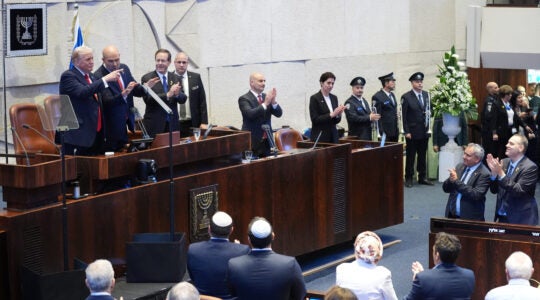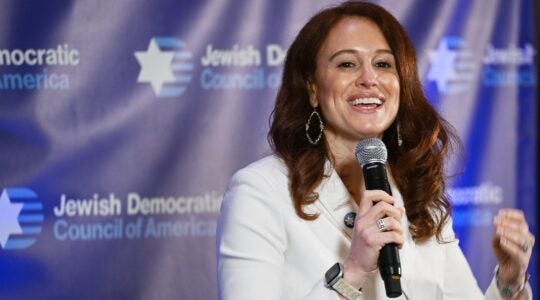NEW YORK (JTA) — The announcement this week that SAR, a modern Orthodox high school in New York, is allowing girls to lay tefillin is helping expose an increasingly sharp fault line within Orthodoxy.
For decades, it has been difficult to sort out the precise dividing lines between the varieties of Orthodoxy — ultra, haredi, centrist, modern, liberal. Each elastic category bled into others, and the movement has been broad enough to encompass everyone from black hat-wearing rabbis with long beards to young women in jeans and T-shirts.
What united them was a stated commitment to halachah — Jewish law traditionally defined — and, of course, self-definition as Orthodox.
In recent years, however, a visible divide has been emerging over a single issue: the role of women. It quickly is becoming a line in the sand, pitting the reformers against the traditionalists.
The decision by SAR High School, located in the Riverdale section of the Bronx, is just the latest development on this front. Before it came the decision by Rabbi Avi Weiss, an Orthodox rabbi in Riverdale, to ordain female Orthodox clergy. The ordination call was preceded by Orthodox minyans that took a second look at halachah and decided that allowing women to lead certain parts of worship — Torah reading, the introductory morning prayers known as Psukei D’zimra and a few other rituals — did not violate the letter of the law.
It’s difficult to say when it all began. Was the original Bais Yaakov school for girls, opened in Poland in 1917, the first breach, breaking the traditional ban on giving girls a formalized Torah education? The school, which by today’s standards would be considered ultra-Orthodox, was then seen as groundbreaking. Only the imprimatur of the widely respected Rabbi Yisrael Meir Kagan, known as the Chofetz Chaim, helped stem the controversy that greeted its establishment.
In America, a key milestone came in the latter half of the 20th century when Orthodox schools began offering girls the same Jewish education offered to boys. For many years — and this is still the case in many Orthodox institutions today — only boys were allowed to study Talmud, the central text of Orthodox Judaism. But when Orthodox schools began allowing girls to study Talmud, under the authority of Rabbi Joseph Soloveitchik of the Maimonides School near Boston, it opened the door to a new way of thinking about the role of Orthodox women.
Many of the logical conclusions followed. If an Orthodox girl could study Talmud in high school, why couldn’t she in college? By the early 1980s, Yeshiva University, the flagship institution of modern Orthodoxy, was offering elective Talmud classes at its Stern College for Women, though it wasn’t until 2009 that Stern opened a master’s program in biblical and Talmudic interpretation to women. In 1984, the Drisha Institute, a New York institution under Orthodox leadership, opened the first full-time women’s kollel study program.
The glass ceiling of female Orthodox spiritual leaders began to shatter, too. In 1992, Drisha began offering a three-year program “paralleling rabbinic ordination” to certify female scholars. A few years later, Nishmat, an institution in Jerusalem established in 1990 “to open the gates of higher Torah learning to women,” inaugurated a program to certify women as “yoatzot halacha” — consultants on Jewish law. The consultants mainly ministered to women on laws pertaining to sex, Shabbat and kashrut.
In 2009, Weiss pushed the envelope even further by ordaining Sara Hurwitz, later conferring on her the title of “rabba,” a feminized version of rabbi. The move was condemned immediately — not just by the haredi Orthodox, but by leaders of the centrist Orthodox Rabbinical Council of America.
“The ordination of women as rabbis represents a serious and inappropriate breach with our sacred tradition and is beyond the pale of Orthodox Judaism,” said Rabbi Steven Pruzansky, a rabbi in Teaneck, N.J., who was vice president of the RCA at the time.
For a long time, it had been unusual for one sector of American Orthodoxy to condemn another, despite differences in practice and even ideology. Many families span the various kinds of Orthodoxy, no one’s quite sure of what the contours of modern Orthodox are, and it’s not unusual to find haredi Orthodox Jews worshiping in modern Orthodox shuls and vice versa. (Neither consider it acceptable to worship in Conservative or Reform synagogues.)
But as liberal Orthodox Jews support new roles for women, particularly in the synagogue, it’s looking increasingly like Orthodoxy is undergoing a schism.
The more traditionalist elements of the Orthodox community view the reforms as beyond the pale, a threat to the integrity of their halachic community. This is why Weiss and the yeshivas he has established, including the liberal Orthodox rabbinical school Yeshivat Chovevei Torah, have faced so much Orthodox opposition — from the RCA, which does not recognize Chovevei ordination, to Israel’s Chief Rabbinate, which recently questioned Weiss’ Orthodox credentials.
Incidentally, SAR is not the first Orthodox school to allow girls to lay tefillin; the Ramaz School in Manhattan made such an allowance as far back as the early 1990s, though it made no public announcement about it until SAR did this week. And eight centuries ago, the daughters of Rashi, the medieval French rabbi, famously were said to have worn tefillin.
While the more public battles have been over women being ordained, laying tefillin or reading from the Torah, there are innumerable issues related to women both large and small with which Orthodoxy is grappling. It’s not just about clergy but also women serving as synagogue presidents, making the blessing over bread or wine on Shabbat, or dancing with Torah scrolls on Simchat Torah. While initially considered aberrant, some of these practices have gradually gained acceptance in mainstream Orthodox circles.
Will the changes considered controversial today gradually gain mainstream acceptance, too, or are they fated to remain a fringe Orthodox phenomenon?
In an elastic movement with no central governing authority or membership structure, it’s hard to say. Clearly the haredi Orthodox will stand against change. The question is which way the modern Orthodox and the institutions associated with them — the RCA, Yeshiva University, the Orthodox Union and the National Council of Young Israel, to name a few — will swing.
There is, perhaps, one factor that may play an outsize role in determining this: leadership. If the change agents within Orthodoxy become educators, role models and leaders of the next generation of modern Orthodox Jews, successfully pass on their commitment to both halachah and egalitarianism, and continue to live a life committed to Jewish law, they could transform the face of modern Orthodoxy.
But if they fail, then those who have been arguing all along that these changes have no place in Orthodoxy will see vindication in that failure.
JTA has documented Jewish history in real-time for over a century. Keep our journalism strong by joining us in supporting independent, award-winning reporting.





